Sugar is a carbohydratemade from a list of vegetables and plants that contain large amounts of sucrose. It is a valuable food product that provides the body with energy and has a positive effect on the functioning of the nervous system (under its influence, the hormone of joy is produced) and at the same time capable of causing significant harm.
Record content:
- 1 Types and composition of sugar
- 2 Calorie content and glycemic index
- 3 Beneficial features
- 4 Harm
- 5 Diseases
- 6 Rate per day
- 7 When does the need increase?
- 8 Signs of a lack of sugar in the body
- 9 When does demand decrease?
- 10 Signs of excess sugar in the body
- 11 Assimilation of sucrose
- 12 List of foods that increase blood sugar
- 13 List of foods that lower sugar levels
- 14 Food products with hidden sucrose content
- 15 How to deal with sugar addiction?
- 16 Sugar Food Videos
Types and composition of sugar
The main constituent substance of the carbohydrate is sucrose - a disaccharide from the group of oligosaccharides, which includes monosaccharides: alpha-glucose and beta-fructose.
Translated from the Indian language, the name means "sand, gravel". The concept came to the Russian language from the Greek word "sakharon". In addition to sucrose, the food product also includes various impurities, and their content in the sand is up to 0.25%, and in the refined product is up to 0.1%.
The main component of sugar belongs to the most widely known disaccharides in nature, which are found in fruits, berries, vegetables and cereals. The largest amount of the substance is contained in sugar beets (industrial crops) and sugar cane (a family of cereals). Typically, these plants are used industrially to produce food.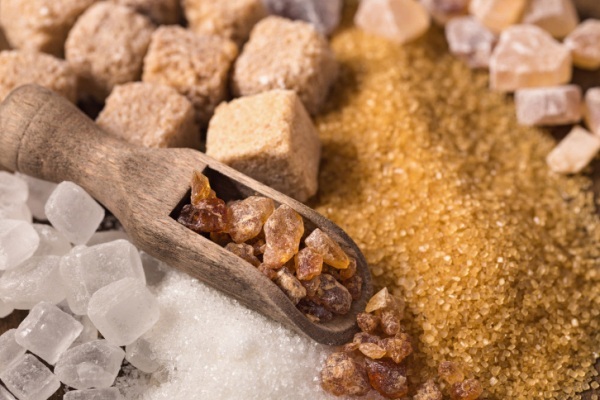
The carbohydrate is divided, depending on the raw material for its manufacture, into the following types:
- Reed the product belongs to perennial herbs cultivated in the tropics and subtropics. Growing a plant requires a warm, humid climate. Harvested mechanically (by cutting). As a result of processing at enterprises, a liquid syrup is obtained, which, through evaporation, is dried and transformed into crystals.
- Beetroot the product is made from a variety of beet, which is a plant with a fleshy root vegetable. Vegetables are grown in regions on fertile soils with a temperate climate. The crop is harvested mechanically. Vegetables are well stored for 5-6 weeks, the juice is extracted from them through a number of industrial technologies.
- Maple sugar is made from the syrup of the same name, obtained from maple sap of any kind. The food production facilities are located in Canada and the USA.
- Palm variety (jaggeri) is produced in southeast Asia, on many islands in the Indian Ocean. The juice is obtained by making cuts in palms (coconut, date, arenga), collecting the liquid and then processing it.
-
Sorghum The product is extracted from annual and perennial herbaceous plants of the cereal family, which are cultivated in Asia, Africa, America, Europe and Australia. The production of crystals from sorghum is an expensive and time consuming process (compared to other industries) with a small amount of finished product in the output.
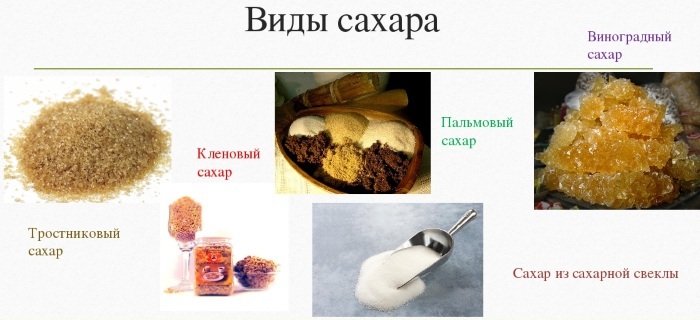
Depending on the manufacturing technology, the product can be white or brownish in color. The white carbohydrate is thoroughly refined with sulfur dioxide or carbonic acid.
Calorie content and glycemic index
Sugar refers to carbohydrate products, that is, organic substances that contain a carbonyl and hydroxyl group. When it enters the digestive system, the product is quickly broken down into glucose (monosaccharide) and fructose (glucose isomer).
A distinctive feature of the carbohydrate is that it provides more than half of the energy required by the body. Serum glucose levels in the range of 80-120 mg / ml are considered normal, that is, from 0.08 to 0.12%. Substances split in the body, supplied with sugar, have the ability to strengthen the barrier function of the liver, counteract harmful toxins.
Foods containing sugar (a list is presented later in the article) are high in calories. Nutritional value of crystals in 1 tsp. l. (4 g) equals approximately 16 kcal. The energy composition of the two types of sugar is summarized in the table.
| Index | White sugar, 100 g | Brown sugar, 100 g |
| Energy value, kcal / J | 387/1616 | 377/1576 |
| Carbohydrates, g | 99,98 | 97,33 |
| Fat, g | 0 | 0 |
| Proteins, g | 0 | 0 |
| Water, g | 0,02 | 1,77 |
White sugar contains useful substances:
- riboflavin (vitamin B12) 0.019 mg;
- calcium 1 mg;
- iron 0.01 mg;
- potassium 2 mg.
The brown sugar contains:
- thiamine (B1) 0.008 mg;
- riboflavin 0.007 mg;
- niacin (B3) 0.082 mg;
- pyridoxine (B6) 0.026 mg;
- folacin (B9) 1 μg;
- calcium 85 mg;
- iron 1.29 mg;
- phosphorus 22 mg;
- potassium 346 mg;
- sodium 39 mg;
- zinc 0.18 mg.

The glycemic index (GI) is a relative measure of the effect of carbohydrates found in food on fluctuations in serum glucose. The GI of glucose is taken as 100 units, refined white sugar - 70 units, brown product - 55 units.
Beneficial features
Scientists in Poland have determined that a complete rejection of sugar is harmful to health, since glucose entering the blood provides half of all the body's energy costs.
The useful characteristics of the product are:
- improving blood circulation in the nervous system and spinal cord;
- the product, taken in normal doses, reduces the likelihood of sclerotic processes;
- used in small doses, it is able to prevent the appearance of blood clots, arthritis;
- protection and maintenance of the normal functioning of the liver.
There is a very common myth regarding the benefits of brown sugar versus white sugar. However, scientists have shown that brown sugar, taken in increased doses, is equivalent to white, harmful to the body. The nutrient content of brown food is too low to have a positive effect on the body.
Harm
When taken in excess, carbohydrate causes significant harm to the body and can provoke a number of diseases.
The negative effects of the product include:
- cardiovascular pathology;
- obesity;
- weak immunity;
- violation of digestive processes;
- wilting and aging of the skin (loss of elasticity, the appearance of rashes, discoloration);
- calcium deficiency (required for the absorption of glucose), fragility of the skeleton, leading to osteoporosis, dental diseases;
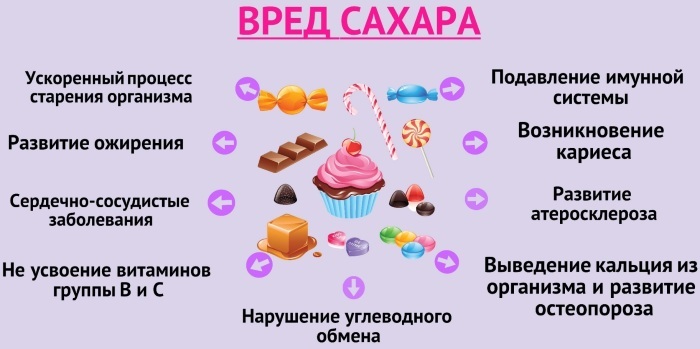
- deficiency of B vitamins, which are also required for the breakdown of glucose (especially B1);
- increased nervous excitability;
- the appearance of anemia;
- vision problems;
- fast removal of complex carbohydrates from the body due to a deficiency of thiamine, which processes them.
Foods containing sugar (the list includes mainly drinks) in large quantities give the body a huge portion of energy, which quickly disappears, leaving fatigue.
Diseases
When glucose enters the body, it usually accumulates in the liver, but this supply cannot be collected continuously. Over time, an excess of the substance begins to be observed, which leads to obesity. A shock intake of sweets provokes a sharp increase in the amount of glucose in the blood, and then a similar sharp decrease as a result of its assimilation.
Gradually getting used to this, the human brain begins to demand the next dose, creating a feeling of hunger. This is how an appetite for sweets appears, which opens the door to overeating, and forms (in the physiological and psychological sense) dependence.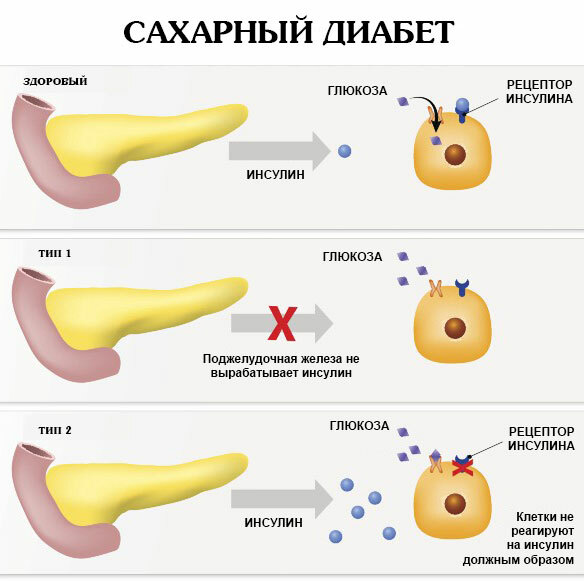
First of all, people who lead a sedentary way of life feel the harm from sugar. Excessive intake of the product leads to a rise in blood insulin, which lowers glucose levels.
However, further an increase in glucose follows again, so a vicious circle is obtained, as a result of which an excess sugar contributes to the general lowering of the insulin level in the body below normal, causing an attack hyperglycemia.
Such conditions contribute to the development of diabetes, a disease that appears due to significant stress on the pancreas, which does not have time to produce enough insulin. In addition, consuming too much sweets can lead to dental problems and excess weight.
Rate per day
The World Health Organization periodically reviews sugar intake. Today, for women per day, it is 50 g, for men - 60 g.
The concept of the norm includes the total amount of sugar taken per day, including that obtained from foods with hidden content. In terms of teaspoons, the rate is 6 tsp. l. or 5.5 cubes of refined sugar.
When does the need increase?
The need for a product increases with the following aspects:
- American physician Jacob Teitelbaum determined that excess sugar levels increase yeast populations in the body. The phenomenon is accompanied by sinusitis, candidiasis, and digestive problems. The pathology is explained by the fact that glucose contributes to the excessive growth of yeast, if you remove excess microorganisms, then the need for sweets goes into decline.
- Scientists claim that the lack of resistance to stressful situations increases the need for sweets. The problem concerns, first of all, perfectionists, lovers of strict order. In people exposed to frequent stress, the adrenal glands suffer, dizziness, headaches, irritability appear, and the tonsils are often inflamed.
- Overcoming chronic fatigue is another reason for the desire for sweets. However, such people do not notice that the effect of the product gives only a temporary result, and then even greater fatigue sets in.
- Scientists have long noticed that increased sugar cravings occur during periods of hormonal imbalance (before menstruation, during menopause, during pregnancy). Aligning the hormonal background solves this problem.
- The need for sucrose increases when a person is engaged in constant brain activity.
- If toxic substances have entered the body, then an additional dose of glucose will help to cope with them.
Signs of a lack of sugar in the body
Foods containing sugar (a list of signs of a lack of glucose in the body is posted later in the article) in low doses can reduce its level in plasma. This phenomenon is called hypoglycemia.. The condition is observed when blood sugar drops to 4 mmol / L (72 mg / ml).
The condition is observed in a number of factors:
- skipping meals;
- if the diet contains a small amount of carbohydrates;
- as a result of physical activity;
- after drinking alcohol or drugs;
- after the introduction of an excessive dose of insulin.
Signs of hypoglycemia are:
- the presence of dizziness;
- increased sweating;
- the appearance of migraines;
- feeling of hunger;
- the presence of lethargy, darkening in the eyes;
- loss of sense of direction;
- mood swings;
- the appearance of seizures, loss of consciousness.
When does demand decrease?
Cravings for sweets are reduced when the following aspects are observed:
- as a temporary phenomenon when consuming large amounts of complex carbohydrates;
- in short-term cases with pathological conditions accompanied by increased body temperature, pain syndrome, burns;
- during an epileptic seizure;
- a persistent decrease in glucose may appear during malfunctions of the digestive system, liver;
- with disorders of the functioning of the endocrine and pancreas, hypothalamus, adrenal glands and pituitary gland;
- with hormonal imbalance (during pregnancy) or the appearance of endocrinopathy;
- the need decreases with a predisposition to diabetic conditions.
Signs of excess sugar in the body
The main reason for the persistent rise in blood glucose levels is diabetes mellitus. Also, the phenomenon is observed with overweight or obesity.
Hyperglycemia can develop unexpectedly and exhibit the following symptoms:
- constant feeling of thirst and dry mouth;
- increased frequency of urination with an increase in volume (urinary incontinence at night);
- feeling of powerlessness, weakness;
- feeling of chronic hunger;
- rapid weight loss;
- blurred vision, blurred visual outlines;
- violation of the metabolism of carbohydrates in the body;
- headaches.
With an increase in blood glucose levels above 30 mmol / l, a high probability of the appearance of life-threatening conditions develops: seizures, respiratory disorders, cardiac activity.
Assimilation of sucrose
Foods containing sugar (the list contains many drinks), entering the body, are broken down into sucrose, which is converted into glucose. At the same time, sugar is absorbed only by 20%, the remaining 80% come out almost unchanged.
This fact suggests that the consumption of sucrose reduces the likelihood of diabetes. At the same time, an increase in the amount of glucose and fructose in the diet in its pure form, on the contrary, increases the risks of the appearance of pathologies associated with metabolic processes.
In a recent study, researchers found that glucose absorption is independent of the time of day. Maintaining consistency between meals has an impact. If a person takes a large amount of sucrose for dinner, then it should be limited during breakfast, and vice versa.
List of foods that increase blood sugar
Foods that increase blood sugar include:
- bakery and pasta with a high glycemic index of 140;
- dried fruits;
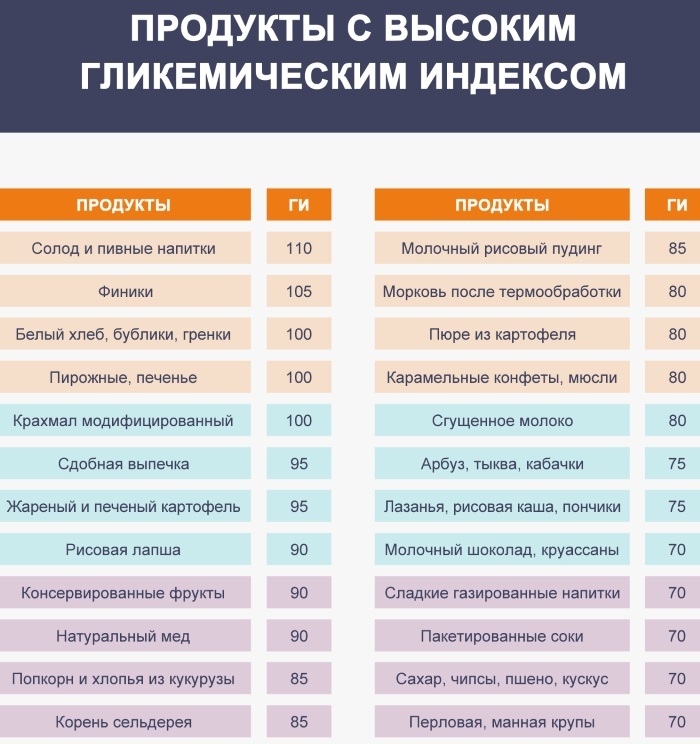
- confectionery baked goods;
- fried potatoes;
- boiled beets and carrots;
- butter;
- rice groats;
- ice cream, chocolate;
- milk and fermented milk products;
- sweet fruits and berries;
- corn.
List of foods that lower sugar levels
The list of foods and meals that lower serum glucose levels include:
- oatmeal is used to prevent diabetes;
- nuts (all varieties), which contain proteins with fats that slow down the process of glucose absorption (the daily dose should not exceed 50 g);
- cinnamon contains polyphenols, fiber and magnesium, which reduce sugar (daily intake of 0.5 tsp. l. spices reduce the risk of diabetes);
- avocado contains fiber, mono saturated fats, potassium, iron, magnesium - substances that help lower blood glucose;
- red bell pepper contains a large amount of vitamins, antioxidants;
- wheat groats contain a large amount of fiber, its daily intake can reduce the risk of diabetes by 20-30%;
- fish in boiled or steamed form should be taken 2 times a week (reduces the likelihood of diabetes by 25%);
- broccoli contains polyphenols;
- legumes with a high protein content slow down the absorption of carbohydrates;
- strawberries are a good antioxidant, a source of fiber and vitamin C, normalize blood sugar levels;
- garlic stimulates the function of the pancreas and thereby the production of insulin, affects the metabolic processes in the body.
Food products with hidden sucrose content
The grocery list that people go to the grocery store usually contains food with a lot of sugar. Moreover, buyers often do not even suspect this.
The list of such products includes:
- canned beans;
- peanut butter;
- tomato sauce, ketchup;
- Low fat yogurt (holds about the same amount of sugar as a bottle of soda)
- protein bars;
- dressings for salads, mayonnaise;
- frozen semi-finished products;
- alcoholic drinks in the form of cocktails with carbonated water, juices, syrups.
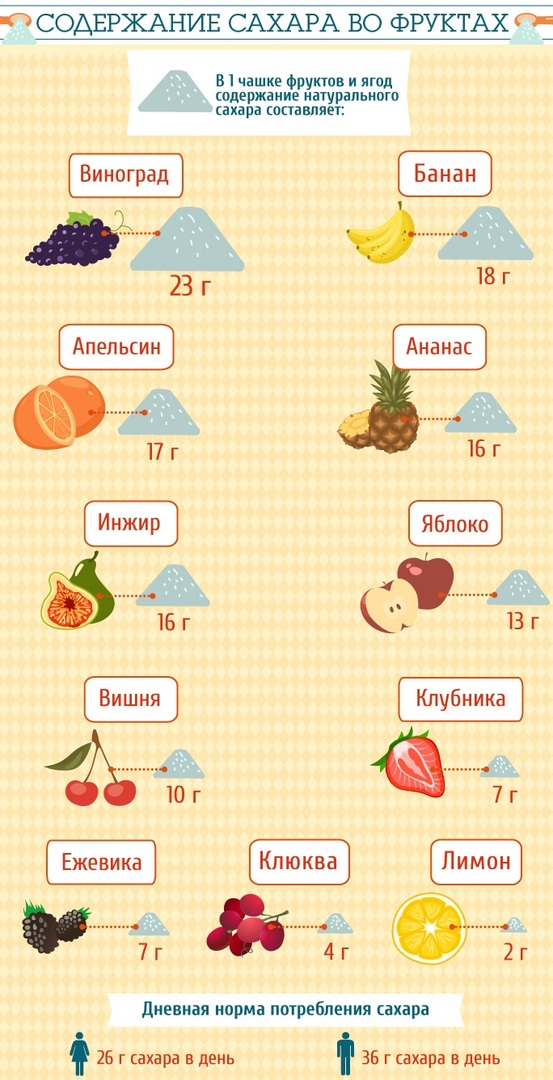
Foods (fruits) containing sugar
The following is a list of foods and beverages that contain high amounts of sugar:
- sweet water "Coca-cola" - 139 g / l;
- cold tea "Nesti" 36 g / l;
- orange juice 24 g / l;
- milkshake 11 g in 0.5 l;
- medium-sized banana 25 g;
- chocolate bar 56 g;
- bar of chocolate bar 40-50 g.
How to deal with sugar addiction?
To reduce dependence on sweets, you must adhere to the following rules:
- When choosing food in the store, you should carefully consider the labels of goods for the presence of ingredients containing sugar (usually they are listed among the first 3 positions).
- It is necessary to abandon the use of white flour and products made from it, since the technology its processing includes the introduction into the composition of substances that provoke the reproduction of yeast-like fungi.
- You need to switch to useful sweeteners (stevia, sorbitol).
- Reduce the amount of coffee to 1 cup per day.
- It is necessary to increase the use of the amount of water (more than 2 liters per day).
- Switching to foods with a low glycemic index (below 42) will lower blood glucose levels.
- You need to switch to a rational meal 5 times a day in small portions.
- Removing juices, carbonated water from the diet and replacing them with natural fruits will prevent the development of diabetes.
- You can include wheatgrass in your diet, which should be taken a handful a day.
Despite the benefits of sugar, the list of negative effects from excessive consumption with food is more impressive. Blood glucose levels can be gradually brought back to normal through dietary revisions and healthy lifestyles.
Sugar Food Videos
5 foods with too much sugar:



